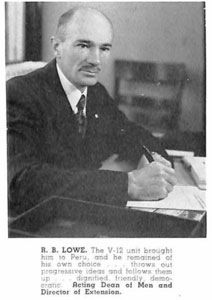FOR IMMEDIATE RELEASE
February 28, 2016, 2:00 p.m. CDT
Contact Jason Hogue, Peru State College Marketing and Communications, 402.872.2429
Peru, Nebraska – Richard Barrett Lowe came to Peru State in February of 1946 to command the Navy
V-12 Program. Lowe would later serve as governor of American Samoa and Guam.
Before coming to Peru, Lowe served as a superintendent in South Dakota cities such
as Alcester, Wessington Springs and Yankton. At the start of America’s involvement
in World War II in 1941, Lowe became president of Sioux Falls College.
Lowe took a break from his education career to serve as a lieutenant in the U.S. Navy.
He became the commander for the V-12 Training Program at the University of Nebraska
and Creighton University.
In 1946, the V-12 Program brought Lowe to Peru State College, then known as Nebraska
State Teachers College. Lowe was soon elected dean at the College.
During this time, Lowe assisted with the US Navy Reserve’s recruiting drive. He greatly
emphasized the importance of education, and he adopted the slogan, “Stay in School.”
Lowe remained active in education on a national level, attending conventions and participating
in panel discussions as a member of the armed forces.
In 1953, President Eisenhower appointed Lowe to be the Governor of American Samoa,
one of the territories in the South Pacific. As Governor, Lowe helped the Samoans
establish a basis for a constitution. He organized a constitutional committee to discuss
plans of possible new legislation for the territory. Lowe also contributed to the
growth of Samoa’s tuna canning industry, which became the country’s leading industry
in the following years.
After three years as Governor of Samoa, Lowe became the Governor of Guam, once again
appointed by Eisenhower. For two weeks, while Lowe moved between American Samoa and
Guam, he acted as governor for both territories. This is the only known instance in
the 20th century of one person governing two sovereign entities at once.
During his time in Guam, Lowe focused his attentions on capital improvements. He organized
construction of multiple properties: an official administration building, that became
a permanent structure in the country; the Territorial College of Guam, which later
became the University of Guam; public elementary and secondary schools; and other
urban buildings in many different villages.
In his inaugural address as Governor of Guam on October 31, 1956, Lowe stated, “I
believe in the dignity of the individual, and that the government of the people should
be an open government, and I bring to you an open mind, an open heart and sincerity
of purpose.”
Lowe was also responsible for improving US relations with Guam after the two entities
fought over an immigration ban passed by the US during Lowe’s governorship.
When Lowe resigned in 1960 from his governorship, he moved to Alexandria, Virginia,
deciding to restore historic houses in the area, including George Washington’s townhouse,
originally built in 1769.
Lowe passed away at age 69 on April 16, 1972, in Alexandria, Virginia. He is buried
at Graceland Cemetery in Madison, South Dakota.
Governor Lowe from the 1946 yearbook.
###
Ashley Peiman contributed to this release.
Thanks to Guampedia.org and Dakota State University for their biographies about Governor Lowe.
